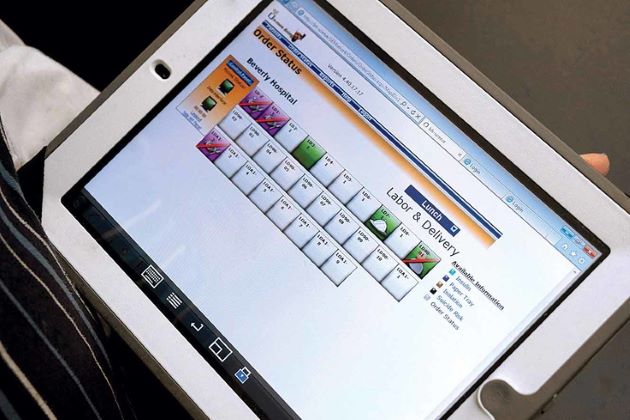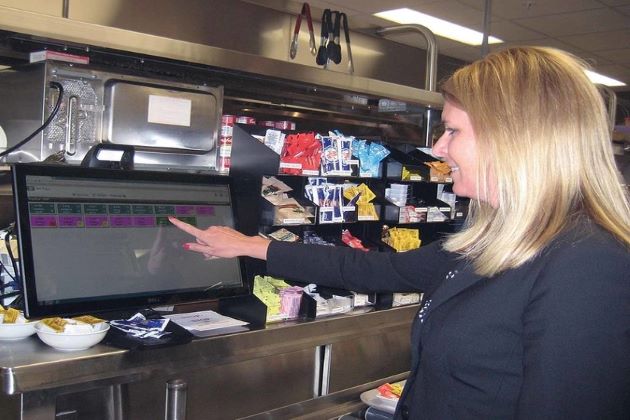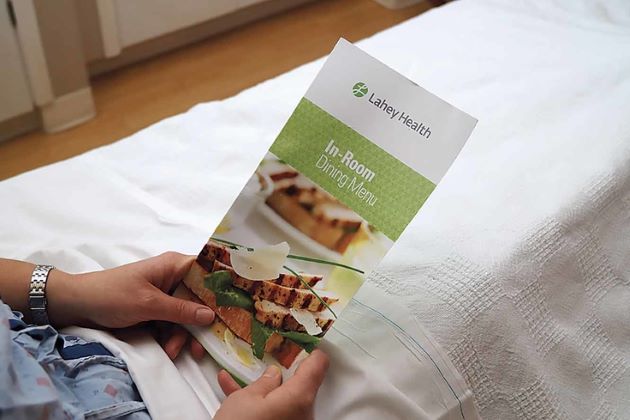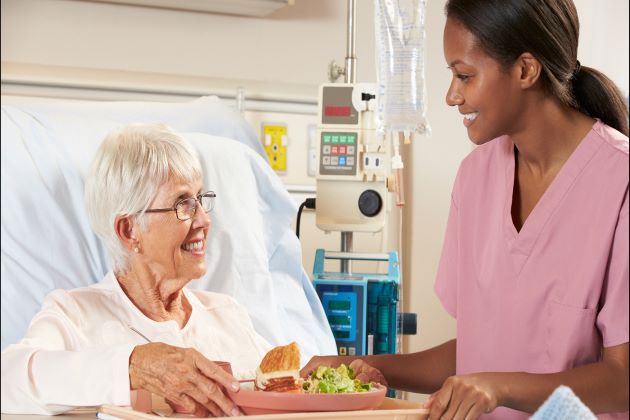Until last year, Shore Medical Center in Somers Point, N.J., relied on paper menus and scheduled delivery times to deliver meals to patients.
That system often caused unnecessary food waste, and it also dragged down patient-satisfaction scores. Some patients got food they didn’t want because items were removed from their order and replaced with substitutes to reflect dietary restrictions and allergies. Other times trays were delivered when patients were away from their room, so if the patient had ordered a hot meal the food would go cold and get thrown away.
Those issues largely disappeared when Shore Medical began using tablet technology to provide food service.
In August 2015, the 198-bed hospital rolled out MyDine, a program from food-service provider Unidine that links information on patients’ dietary restrictions and allergies stored in their electronic health record to tablets used by staff members (referred to as guest-service representatives). They interact with patients one-on-one to discuss menu options that reflect their diet while also making sure patients are ordering what they want and when they want it.
The tablets automatically update every 30 seconds with dietary changes made in the patient’s EHR so the representatives discuss only the menu items the patient is actually allowed to have.
Hospitals are increasingly investing in modernizing their food-service systems. The change reflects the broader effort by hospitals to cut costs and inefficiencies while improving patient satisfaction and the quality of care. Technology is also helping health systems standardize meal options across their networks, support on-demand room service and deploy analytics to reduce food waste.
Shore Medical Center says the technology is a factor in a 10% improvement in its patient-satisfaction scores in the past year and credits the system with saving about $25,000 yearly because of less food waste.
“It’s heavy in patient interaction, and it just makes (patients) feel like they have a choice. It puts the controls within the patient’s hands,” said Bob Robertson, who oversees Shore Medical’s food services as administrative director of logistics.
For more and more hospitals, food service has become an essential part of improving the patient’s overall experience, said Tom Warren, senior vice president and chief operating officer of Boston-based Unidine.
Although the CMS’ Hospital Consumer Assessment of Healthcare Providers and Systems, or HCAHPS, survey does not specifically ask about food service, it does influence the score, Warren said. When patients reflect on their time in a hospital, they remember if the people who brought their meals were friendly and if their food was good and delivered on time. “Most people don’t understand the medical procedures, but they do know about food,” he said.

The influence that the dining experience can have on a patient’s overall impression of a facility has encouraged more providers to invest in new ways to improve the service, Warren said. One tactic is room service. About 48% of hospitals provide on-demand room service for patients, according to a May survey of 184 providers by FoodService Director magazine. About 67% of facilities with a food and beverage budget over $5 million reported using room service.
The role of the food-service staff is also changing. They are expected to do more than just take orders. They are also supposed to make the patient’s stay more comfortable. “Our people provide that feeling of hospitality and caring. (Physicians) are very busy. Our (staff) has the time to have interactions, and they are part of the overall experience,” Warren said.
Unidine’s guest service representatives at Shore Medical are a critical connection point for the patient and the rest of the care team, said Saba Zahid, patient experience manager at the facility.
The representatives are divided by floor and spend most of their shifts interacting with patients. Representatives handle about 30 patients each. It’s from one-on-one moments with patients that the representatives can make observations such as whether or not the patient ate their meal, Zahid said. The representatives can then pass on any questions or concerns to the patient’s nurse, dietitian or clinician. “They actually become part of the patient-care team.”
Unidine competitor Aramark has a similar program for customers with inpatient facilities. The service, called Patient Connect, enlists staff members to take down food orders for patients using mobile devices.

Aramark’s “patient ambassadors” are encouraged to not only address food with patients but also discuss any other issues they have, said Gary Crompton, president of the healthcare hospitality group at the Philadelphia-based company. If issues are addressed before a patient is discharged, they are less likely to end up on the HCAHPS survey, he said. Patient-satisfaction scores have risen by as much as 37 points for environmental services and 43 points for nutrition services across 285 facilities that use Aramark’s Patient Connect, according to the company. “We like to have as many touch points that we can with the patient to give a sense that we really are concerned about their care and their experience.”
At the same time, the adoption of EHRs has opened up opportunities for providers to transform food service, such as the way Unidine’s tablets are linked to digital records to allow physicians to update dietary restrictions and have them carry over seamlessly to the patient’s menu options.
About a year ago, Milwaukee-based Aurora Health Care rolled out technology that allows on-call room service and meal options that are standardized across the 15-hospital system. Aurora says the system, provided by food-service management company Cbord, has improved efficiency and provided opportunities to better monitor services.
Cbord’s paper menus include nutritional facts such as carbohydrates per meal. Patients can call the diet center anytime between 7 a.m. and 7 p.m. when they are ready to eat. As patients place orders on the phone with a clerk, the clerk has access on a computer to the patient’s medical information, including allergies and physician diet orders. The clerk can also discuss the patient’s food preferences.
Meals are then prepared and delivered within 45 minutes. The food-service staff carries iPads for meal delivery and check off when a tray has arrived in a patient’s room.

“We’ve seen a huge decrease in the number of meals served because patients are actually getting what they want,” said Lisa Schairer, vice president of food and nutrition services at the health system. “They don’t need to order a second time.”
Aurora Health Care has also saved by trimming food vendor contracts down from 186 to fewer than 100, assessing inventory on hand, and rigorously reviewing outcomes. Schairer said the food-service team holds monthly meetings to go over processes and spot inefficiencies. For example, the team tracks tray delivery times to ensure facilities are delivering meals within the 45-minute time frame. The efforts have led to about $4 million in yearly cost savings for the system, Schairer said.
But Schairer points out that adopting technology and new processes requires more time to train staff. “It is a fluid system so it is constantly being updated” as menu items change.
Technology is also allowing providers and their vendors to get a better handle on waste. Aramark, which has more than 800 hospital customers, has set a goal of wasting less than 4% of the food prepared and served at its clients’ facilities.
To accomplish that, Aramark tracks how many meals are served and the ingredients needed for recipes. “Because we have so many hospitals, we can aggregate that data and we can start to see trends,” Crompton said. “It not only gives the front-line managers information to better serve the patients, but it gives me the information to go to the supply chain and say, here are the things we can do to help the process.”

